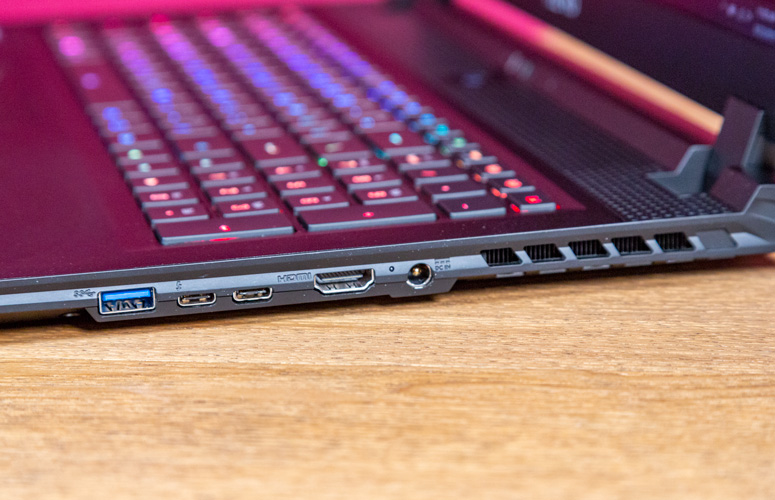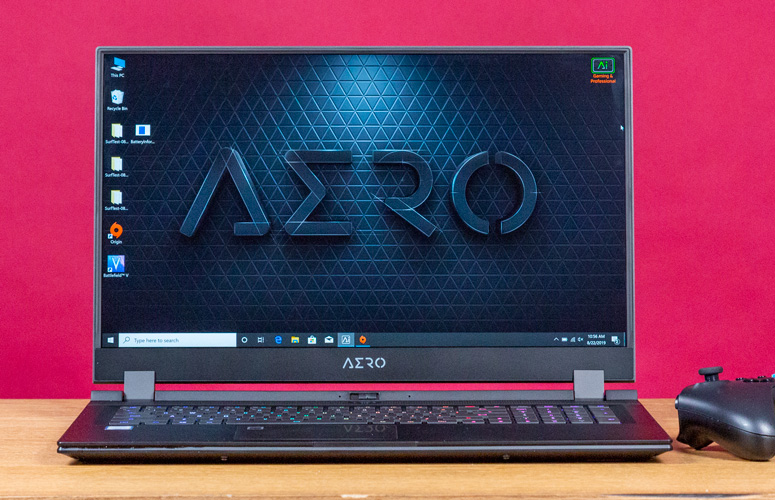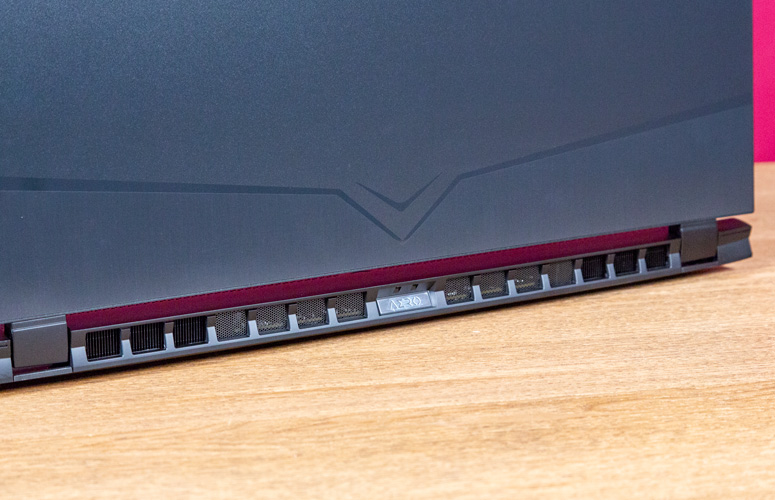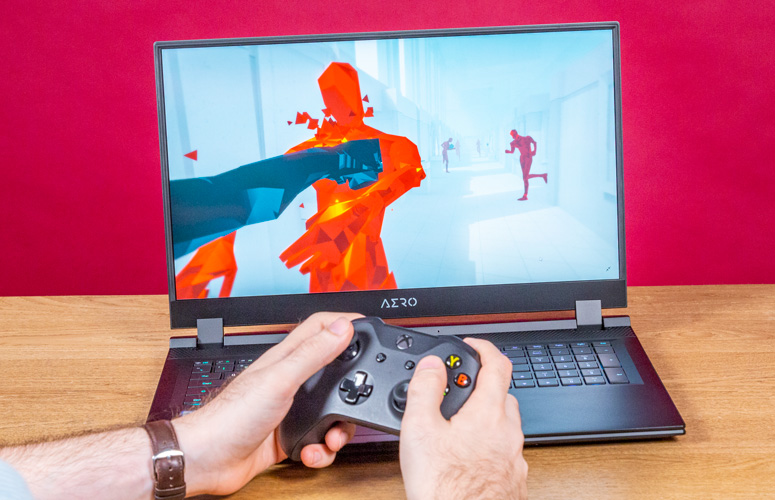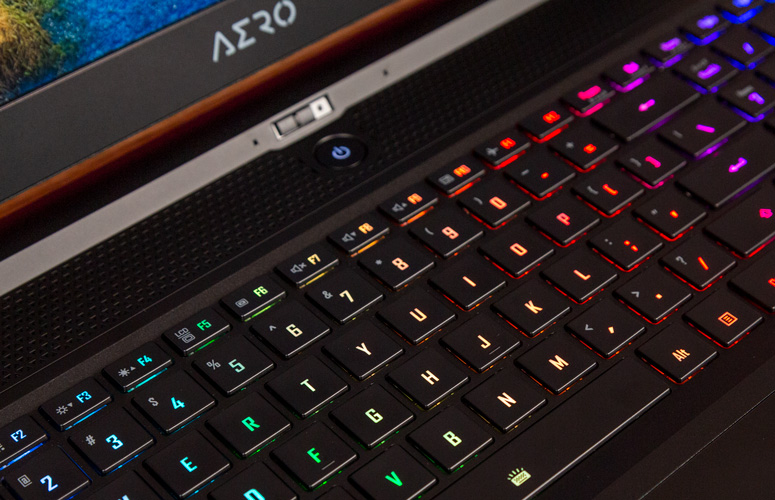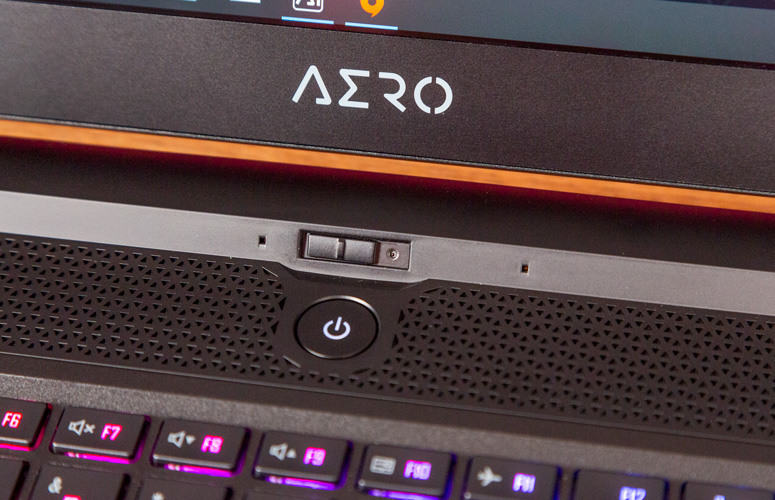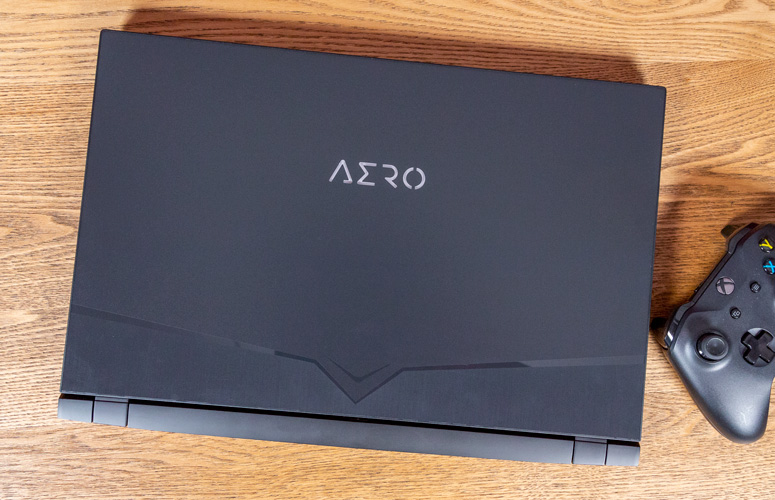Laptop Mag Verdict
The Gigabyte Aero 17 HDR boasts a bright 4K display, good battery life and strong overall performance packed into a slim design.
Pros
- +
Sleek aluminum design
- +
Bright, 4K display
- +
Good battery life
- +
Comfortable keyboard
- +
Strong overall performance
Cons
- -
Bottom-bezel webcam
- -
Graphics slightly behind competition
Why you can trust Laptop Mag
Gigabyte's Aero 17 HDR is a beast of a gaming machine. For $3,199, you get all the bells and whistles, including a gorgeous 17.3-inch, 4K HDR display, a super-comfortable keyboard, solid battery life and strong overall performance, all packed into a sleek design.
Ironically, it lacks in one respect: gaming performance. Its RTX 2070 Max-Q GPU isn't bad per se, but it's just slightly behind the competition. Another issue is that the Aero 17 boasts a webcam located near the bottom bezel. However, the Aero 17's other qualities are so great that it still makes its mark as a good gaming laptop and one of the best 4K laptops.
Price and configuration options
I tested the Aero 17 HDR XA configuration, which costs $3,199 and is outfitted with an Intel Core i9-9980HK processor, an Nvidia GeForce RTX 2070 Max-Q GPU with 8GB of VRAM, 16GB of RAM and a 512GB M.2 NVMe PCIe SSD.
The base model, the Aero 17 HDR SA, runs for $1,999 and drops you to a Core i7-9750H CPU, a GTX 1660 Ti GPU, 8GB of RAM and a 256GB SSD.
At $4,095, you can get the Aero 17 HDR YA, which is armed with a Core i9-9980HK CPU, an RTX 2080 Max-Q GPU, 64GB of RAM and a 1TB SSD.
If you're looking for something a little cheaper, consider a gaming laptop under $1,000, or peruse our gaming laptop buying guide.
Sign up to receive The Snapshot, a free special dispatch from Laptop Mag, in your inbox.
Design
The Aero 17 sports an identical design to its 15-inch counterpart, the Aero 15. Its black, aluminum hood features a white, glowing Aero logo above the center. Below that, there's a glossy-brushed design that resembles a bow releasing an arrow toward the hinge. In addition, there's an engraved Aero logo on the hinge accompanied by two white LEDs acting as spotlights.
Meanwhile, the interior packs a per-key RGB-lit keyboard, a fingerprint sensor and a thick, triangle-patterned air vent just above the keyboard. Like its sibling, the panel sports slim bezels at the cost of webcam placement on the hinge. Although it does have a privacy shutter, I wouldn't worry about your camera being hijacked, since it won't see anything but your nostrils anyway.
At 5.8 pounds and 15.6 x 10.6 x 0.8 inches, the Aero 17 is rather slim for a 17-inch gaming laptop, so it should fit in most 17-inch laptop bags. The Alienware m17 R2 (5.7 pounds, 15.7 x 11.6 x 0.7~0.8 inches) is around the same range, but obviously its 15-inch competitors -- the Razer Blade 15 (4.7 pounds, 14 x 9.3 x 0.7 inches) and the Lenovo Legion Y740 (5 pounds, 14.2 x 10.5 x 0.9 inches) -- were lighter.
Ports
There's an almost identical amount of ports on the Aero 17 compared with the Aero 15, but the former boasts additional audio ports.
On the left, there's an RJ45 Ethernet port, an SD card slot, one USB 3.1 port, a microphone input, a headphone input and one USB 3.1 port.
The right side holds room for the power jack, an HDMI 2.0 port, one USB Type-C/DP 1.4 port, one Thunderbolt 3 port and one USB 3.1 port. If you need additional ports, consider getting a USB Type-C hub or a docking station.
Display
My eyes! The Aero 17's 17.3-inch, 3840 x 2160 HDR panel is kick-ass. It's crazy bright and colorful, making its "HDR" label proud. Forget about needing a gaming monitor for this beast.
In Shadow of the Tomb Raider, the lush greenery popped in contrast to the red, green and yellow shanty houses that surrounded me. When I dove into a swamp, I could see the details in the rocks around the darkest corners. And the cracks on the wood houses were incredibly sharp, even at several feet away.
Despite being in the depths of dark space, I could see every little star that surrounded the planet Saturn in the trailer for Ad Astra. When it cut to the moon, the blue and green neon signs dotting the sci-fi city popped on the Aero 17's display. Brad Pitt's stubble looked sharp as nails on the 4K screen.
According to our colorimeter, the Aero 17 covered 165% of the sRGB color gamut, flying past the average premium gaming laptop (147%) as well as the Alienware m17 R2 (140%), the Razer Blade 15 (149%) and the Legion Y740 (112%).
MORE: Best Gaming Laptops
At 575 nits, the Aero 17 blasted its opponents with its sun-like beams, blowing away the category average (317 nits), the Alienware m17 R2 (395 nits), the Razer Blade 15 (262 nits) and the Legion Y740 (267nits).
Keyboard and touchpad
Each of the Aero 17 keys felt smooth and tactile as I sped my way through this review in Google Docs.
I hit 70 words per minute on the 10fastfingers.com typing test, which meets my exact wpm average. The keys traveled at 1.6 millimeters and required 71 grams of actuation force, which is well within our preferred range.
The Aero 17's per-key RGB lighting can be controlled via the Gigabyte Control Center's Fusion tab. You can enable effects like Wave, Breathing and Raindrop, and you have the option to assign each key a specific color.
The 4.1 x 2.7-inch touchpad is exactly the same as the Aero 15's. It's soft and relatively clicky, but it's hard to get over the loss of real estate due to the embedded fingerprint reader. Windows 10 gestures, like three-finger tabbing and two-finger scrolling, worked as intended. However, you'd probably want to pick up a gaming mouse for more precision.
Audio
Although the Aero 17's bottom-firing speakers aren't as loud as I'd like them to be, they sounded pretty decent. From the cawing and croaking of animals to kids splashing water at each other in a pond, I was immersed in Shadow of the Tomb Raider's world. Its sounds were smooth, with an elegant balance between proper bass and treble, unlike the Aero 15's sharp speakers. I spoke to one of the natives, and his voice was deep and full, eliciting my full attention when he spoke. I ran out of town in anticipation of hearing what the bow sounded like, and when I unleashed my arrow at an unassuming rock, I heard that satisfying snap I was aching to hear.
After listening to Linsidy Stirling's "Underground" for the past few days, I was hoping to get the same experience on the Aero 17's speakers, and, boy, did I. The opening violin was appropriately soft, and it hit those highs just right until the beat finally dropped with short, sharp notes. However, I moved to Stirling's "Love Goes On and On" to get a read on the vocals, and Amy Lee's voice could have sounded brighter.
MORE: Can I improve my headphone experience while gaming?
Like with the Aero 15, the Aero 17 comes with the Nahimic audio software, which features four presettings: Music, Movie, Communication and Gaming. You can adjust settings like bass, treble, voices and surround sound. The audio sounded good without any tinkering when it was set to Music and Gaming. Regardless, a pair of headphones or computer speakers couldn't hurt.
Gaming, Graphics and VR
Beneath the hood of the Aero 17 lies an Nvidia GeForce RTX 2070 Max-Q GPU with 8GB of VRAM that blasted through Shadow of the Tomb Raider at 59 frames per second as I ran and jumped around a village in South America. However, the Aero 17's performance doesn't stack up well against the competition.
On the Shadow of the Tomb Raider benchmark (Highest, 1080p), the Aero 17 averaged 59 fps, sliding by the 63-fps premium gaming laptop average. The Legion Y740's RTX 2070 Max-Q GPU fell below the Aero 17, at 55-fps, while the Alienware m17 R2's RTX 2080 GPU nailed 71 fps. At 4K, the Aero 17 hit 19 fps, a few frames behind the 22-fps category average.
The Aero 17 got 90 fps on the Hitman benchmark (Ultra, 1080p), which is not only behind the premium gaming laptop average (107 fps) but also the Alienware m17 R2 (111 fps), Razer Blade 15 (RTX 2070 Max-Q; 96 fps) and Legion Y740 (96 fps). On the 4K test, the Aero 17 hit 46 fps, falling short of the 53-fps category average.
On the Grand Theft Auto V benchmark, the Aero 17 nailed 77 fps, matching the premium gaming laptop average while surpassing the Razer Blade 15 (76 fps) and the Legion Y740 (67 fps). It was bested by the Alienware m17 R2 (82 fps). At 4K, Aero 17 scored 25 fps, missing the 29-fps category average.
MORE: Best Graphics Performance
The Aero 17 hit 82 fps on the Middle-earth: Shadow of War benchmark (Ultra, 1080p), falling short of the premium gaming laptop average (95 fps) as well as the scores from the Alienware m17 R2 (100 fps), Razer Blade 15 (91 fps) and Legion Y740 (87 fps). When I benchmarked it at 4K, the Aero 17 hit 36 fps, short of the 41 fps category average.
Microsoft Azure AI
Like the recent Aero 15 laptops, the Aero 17 features software called Gaming+ and Professional+ that optimizes your performance with help from Microsoft's Azure AI. We've done comparisons on the Aero 15 OLED and Aero 15 Classic, so you can see the differences yourself, but ultimately, this software is the equivalent of throwing any gaming performance utility on the Automatic setting. Except the difference is that it's Microsoft's Azure AI calling the shots. Overall, we didn't see much of an improvement throughout our testing.
To break down the modes real quick, there's AI Edge Learning, which doesn't connect to the cloud but can adjust performance based on the data it's collected. AI Azure Download connects fully to the cloud, but doesn't share your settings, so the Azure AI cannot collect data. Finally, AI Azure Download and Upload connect to the cloud to download settings as well as upload your data.
Performance
What the Aero 17 lacks in graphics performance, it makes up for in raw power, with its Intel Core i9-9980HK processor and 16GB of RAM. It blazed through 40 Google Chrome tabs and five 1080p YouTube videos while running Shadow of the Tomb Raider in the background.
On the Geekbench 4.1 overall performance test, the Aero 17 scored 28,879, blowing past the premium gaming laptop average (24,362) as well as the Core i7-8750H CPUs in the Razer Blade 15 (22,379) and the Legion Y740 (21,629). However, the Alienware m17 R2 was slightly ahead, at 29,862, thanks to its Core i9-9980HK CPU.
The Aero 17 transcoded a 4K video to 1080p in just 8 minutes and 8 seconds, crushing the category average (9:24), the Razer Blade 15 (12:53) and the Legion Y740 (9:23). But the Alienware m17 R2 (6:55) took the victory lap once again.
MORE: Laptops with the Best Overall Performance
Gigabyte's 512GB SSD copied 4.97GB of data in 11 seconds, translating to 463 megabytes per second, which is far from the premium gaming laptop average (761 MBps). We saw better performance from the Alienware m17 R2's dual 512GB SSDs (1,018 MBps), the Razer Blade 15's 512GB SSD (636 MBps) and the Legion Y740's 256GB SSD (566 MBps).
Battery life
For a gaming laptop with a 4K display, the Aero 17 has a rather impressive battery life. After continuously surfing the web over Wi-Fi at 150 nits of brightness, the Aero 17's battery lasted a whopping 5 hours and 30 minutes, trouncing the premium gaming laptop average (3:20). The Alienware m17 R2 (4:00), Razer Blade 15 (5:02) and Legion Y740 (2:16) couldn't even touch it.
Webcam
This 720p is not only bad because of its poor angle, it's bad because -- well, it is. My entire face was blotchy in the test shots I took. And for some reason, the colors were very warm, so my white shirt had a red tint.
And while the ceiling lights were blindingly bright, parts of my face were so dark that they were nearly black. Save yourself some trouble and pick up an external webcam.
Heat
The Aero 17 can get a little toasty under the hood. After playing Shadow of the Tomb Raider for 15 minutes, the underside measured 114 degrees Fahrenheit, climbing over our 95-degree comfort threshold. The center of the keyboard and the touchpad hit 92 and 84 degrees, respectively. Meanwhile, the hottest it got was 148 degrees, located on the upper underside where the vents are.
On our normal heat, the Aero 17 felt cool. After streaming a 15-minute 1080p video, the underside hit 91 degrees, the keyboard, 87 degrees, and the touchpad, 82 degrees.
Software and warranty
There's not much software included with the Aero 17. There's the Gigabyte Control Center that lets you monitor and change performance speed; tweak display, battery and Wi-Fi settings; customize the keyboard lighting; and control the fan speed.
There's also the Killer Control Center app, which lets you prioritize your bandwidth. And there's Windows 10 bloatware like Farm Heroes Saga, Microsoft Solitaire and Netflix.
The Aero 17 comes with a one-year limited warranty.
Bottom line
Gigabyte's Aero 17 HDR boasts a ton of excellent qualities for a gaming laptop -- a bright 4K display, comfortable keyboard, solid battery life and great overall performance -- everything except for gaming performance, and a well-placed webcam (sigh).
If you're looking for a 17-inch gaming laptop with bangin' graphics performance, go with the Alienware m17 R2. For $3,579, you get a powerful RTX 2080 GPU and comfortable keyboard packed into a much more impressive design.
But overall, the Aero 17 HDR makes for a great gaming laptop, impressing with its display and battery life.
Credit: Laptop Mag
- Gigabyte Aero 15 Classic vs. Razer Blade 15: Which RTX Gaming ...
- Aorus & Gigabyte Gaming Laptops - Brand Rating and Report ...
- Gigabyte Targets Creators with Aero 15, 17 Laptops
Gigabyte Aero 17 HDR Specs
| Bluetooth | Bluetooth 5.0 |
| Brand | Gigabyte |
| CPU | Intel Core i9-9980HK processor |
| Display Size | 17.3 |
| Graphics Card | Nvidia GeForce RTX 2070 Max-Q GPU |
| Hard Drive Size | 512GB |
| Hard Drive Type | PCIe m.2 SSD |
| Highest Available Resolution | 3840 x 2160 |
| Native Resolution | 3840 x 2160 |
| Operating System | Windows 10 Pro |
| RAM | 16GB |
| Size | 15.6 x 10.6 x 0.8 inches |
| Touchpad Size | 4.1 x 2.7-inch |
| Video Memory | 8GB |
| Weight | 5.8 pounds |
| Wi-Fi Model | Killer Wi-Fi 6 AX1650x |

Rami Tabari is the Reviews Editor for Laptop Mag. He reviews every shape and form of a laptop as well as all sorts of cool tech. You can find him sitting at his desk surrounded by a hoarder's dream of laptops, and when he navigates his way out to civilization, you can catch him watching really bad anime or playing some kind of painfully difficult game. He’s the best at every game and he just doesn’t lose. That’s why you’ll occasionally catch his byline attached to the latest Souls-like challenge.



